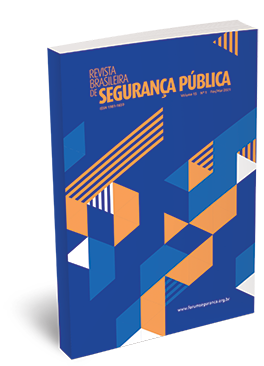Domestic violence against women and the possible relationship with economic and social indicators
DOI:
https://doi.org/10.31060/rbsp.2021.v15.n1.1182Keywords:
Intrafamily violence, Public security, South of Minas Gerais, Domestic violenceAbstract
The crimes of domestic violence against women are characterized as those that occur in the context of family relations, this criminal mode came to be considered a public policy from the year 2006 with the edition of the law named "Maria da Penha" when crimes of domestic violence began to be monitored more closely by governments and public security agencies. Through this work a comparative descriptive analysis of the records of crimes against domestic violence against women occurred in 2018 in the South and North of the State of Minas Gerais will be carried out, seeking a possible relation between the socioeconomic indicators of these regions and the records of domestic violence. The work was developed using official data sources published through Minas Gerais government websites. It was found that there is a correlation between favorable social economic indicators and the high number of records of occurrences of domestic violence.
Downloads
References
CERQUEIRA, D. et al. Avaliando a Efetividade da Lei Maria da Penha. Texto para discussão, Brasília, n. 2048, p. 1-36, mar. 2015.
DE ALCÂNTARA, Patrícia Pereira Tavares et al. Perfil da Mulher vítima de violência de gênero: um estudo documental. Revista E-Ciência, v. 6, n. 1, 2018.
DE LUCENA, Kerle Dayana Tavares et al. Associação entre a violência doméstica e a qualidade de vida das mulheres. Revista Latino-Americana de Enfermagem, v. 25, p. 1-8, 2017.
DIAS, Isabel. Exclusão social e violência doméstica: que relação?. Sociologia: Revista da Faculdade de Letras da Universidade do Porto, v. 8, 2017.
IBGE. Censo demográfico 2010. IBGE: Insituto Brasileiro de Geografia e Estatística, 2010.
IBGE. Divisão regional do Brasil em geográficas imediatas e regiões geográficas intermediárias 2017. Rio de Janeiro: IBGE: Insituto Brasileiro de Geografia e Estatística, 2017.
MACDONALD, Ziggy. Official crime statistics: their use and interpretation. The Economic Journal, v. 112, n. 477, p. F85-F106, 2002.
MADALOZZO, Regina; FURTADO, Giovanna Maia. Um estudo sobre a vitimização para a cidade de São Paulo. Brazilian Journal of Political Economy, v. 31, n. 1, p. 160-180, 2011.
MARTINS, Jayne Cecília. Determinantes da violência doméstica contra a mulher no Brasil. 2017. Tese de Doutorado. Dissertação de Mestrado em Economia Aplicada, Universidade Federal de Viçosa, Viçosa, Brasil). Retrieved from http://www. locus. ufv. br/handle/123456789/12860.
MINAS GERAIS, Minas em Números. A situação econômica e Social de Minas Gerais.
MOREIRA, Gustavo Carvalho et al. Programa Bolsa Família e violência doméstica contra a mulher no Brasil. Estudos Econômicos (São Paulo), v. 46, n. 4, p. 973-1002, 2016.
RIBERO, Rocio; SÁNCHEZ, Fabio. Determinants, effects and costs of domestic violence. Documento, CEDE, v. 38, 2005..
SENADO FEDERAL, Brasil. Lei Maria da Penha.
WHOQOL Group. The World Health Organization quality of life assessment (WHOQOL): Development and general psychometric properties. Social science & medicine, v. 46, n. 12, p. 1569-1585, 1998.
ZALUAR, Alba. UM DEBATE DISPERSO violência e crime no Brasil da redemocratização. Revista São Paulo em Perspectiva, v. 13, p. 3, 1999.
Downloads
Published
How to Cite
Issue
Section
License
Copyright (c) 2021 Revista Brasileira de Segurança Pública

This work is licensed under a Creative Commons Attribution 4.0 International License.
Licensing
The Brazilian Journal of Public Security uses the Creative Commons License as a form of licensing for its published works. The license used follows the CC BY 4.0 - Attribution 4.0 International model.
To see the permitted rights please go to the full licence or to our Copyright and Licensing page.



